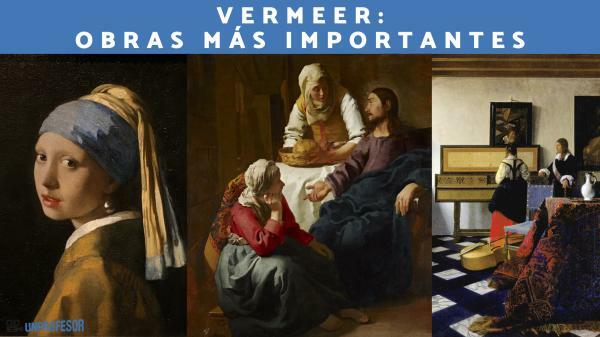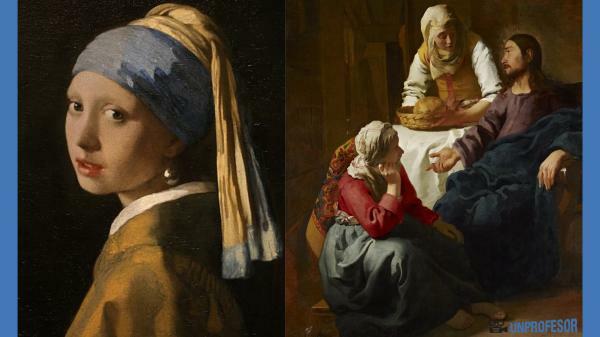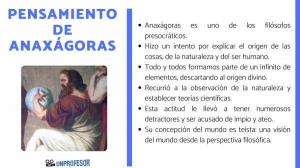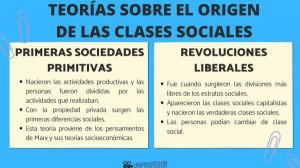Vermeer: most important works

Among the most important works of Johannes Vermeer is one of the most mysterious and suggestive works of universal painting, the iconic “The “Young Woman with a Pearl Earring” (1665), also highlighting “Christ in the House of Martha and Mary” (1654-56), “The Pimp” (1656) and “The Music Lesson” (1662-1665), among others. Here we tell you the story behind these excellent works by Vermeer.
Johannes Vermeer (1632-1675) was a Dutch baroque painter considered, along with Rembrandt, as one of the most relevant figures of the Dutch Golden Age, although only 34 paintings are attributed to him. His concern for light and optical effects, the use of the camera obscura or his inclination to depicting the daily life and interiors of the middle class are some of the most prominent features of his work.
In this lesson from a TEACHER we present four of the Vermeer's most important works so you can admire the mastery of this great Dutch baroque painter.
Index
- Girl with a Pearl Earring, Vermeer's most important work
- Christ in the House of Martha and Mary, one of Vermeer's first works
- The Pimp (1656)
- The music lesson (1662-1665)
Girl with a Pearl Earring, Vermeer's most important work.
This work is also known as the Mona Lisa of the North. A painting that has aroused the curiosity of a large number of scholars both for the admirable use of light and for the subject and the protagonist of the portrait.
The work is of the genre tronie (face in Dutch), a very popular genre in the Dutch Golden Age. Tronie make reference to small portraits in which the painter shows off his virtuosity when portraying characters with exaggerated expressiveness or extravagant details. In “Girl with a Pearl Earring,” Vermeer depicts a seated young woman looking at the viewer with a vibrant and intense, parted lips and the most exotic clothing: a blue and yellow turban and a large gold earring. pearl.
The figure of the protagonist girl is most enigmatic, without anyone knowing who she really is. It is considered that she may be the eldest daughter of the painter or that of her patron, however, the fact that Vermeer's contemporary painters considered her a tronie makes one think that she would not be a real person, or as she appears in the novel of the same name by Tracy Chevalier, The girl of the pearl could have been one of the painter's maids, an anonymous girl, as was usual in this genre.
Vermeer would have demonstrated in this painting his great mastery of light both on the girl's face and clothes. A close and mysterious character at the same time, being an icon of the concept of beauty in the world. baroque art, without giving up introducing those details of luxury and opulence so much to the taste of the bourgeoisie of the time: the shine of the pearl on the earlobe (studies Current studies point out that the pearl is an optical illusion caused by a few strokes of white tone given to create the sensation of the reflection of the blouse or the turban).
A masterpiece that shows an everyday moment and the mastery of natural light and Renaissance techniques, such as chiaroscuro. We encourage you to learn more about this work by Vermeer with this other lesson on Girl with a Pearl Earring: Meaning and Analysis.

Christ in the House of Martha and Mary, one of Vermeer's first works.
In this work, the painter represents a scene biblical interior in which Christ is cared for by the sisters Martha and Mary in a room in his house. Martha offers him some bread, while Mary sits at Jesus' feet to listen to her word. An intimate interior that captures an everyday moment with warm light and a serene tone.
Scholars point out that Vermeer would have shown in this painting both the more active Catholic lifestyle and the more contemplative style of Protestantism. In these years there was a conflict between Protestants and Catholics and Vermeer, recently converted to Catholicism, captured these two religious tendencies personified in the two sisters.
The Pimp (1656)
In addition to biblical scenes, Vermeer was also inspired by more mundane stories and he represented moments like those collected in this work. Thus, it is believed that The Pimp shows us a scene in a brothel. It shows a young woman dressed in light yellow surrounded by two men and a woman who stands on one side mischievously contemplating the scene.
The woman in yellow receives a gold coin from one of the men while she touches his chest. This man appears with his face hidden by the brim of his hat. The other figure, some believe to be Vermeer himself, stands on the side smiling at the viewer while holding a drink and a musical instrument in his hands.

The music lesson (1662-1665)
Once again we find ourselves faced with a indoor scene, an everyday moment between a lady and gentleman. The woman is sitting on a virginal and he receives music lessons from a teacher. The man has his mouth slightly open as if he were singing to the music the girl is playing. It is assumed that Vermeer thus suggests to us the love relationship between both characters, thus combining love and music.
This is one of the common themes of Dutch baroque art, also being a work in which Vermeer shows us his mastery of light by representing objects that already appeared in his paintings with different light and shadow effects. The carpet, the water jug, some musical instruments, the tiles and the windows are constants in his paintings.
After learning about these four important works by Vermeer, we encourage you to continue discovering this era with this lesson on the Representatives of baroque painting.
If you want to read more articles similar to Vermeer: most important works, we recommend that you enter our category of History.
Bibliography
- BLADE, Rafael. Vermeer's Interiors, History and Life, 2011, no 525, p. 81-83.
- BROOK, Timothy; ORDOÑEZ DIVÍ, Victoria, Vermeer's hat. Tusquets Editores SA, 2019.
- FISCER LAMELAS, Guillermo, Art and social classes; Vermeer and Meunier. Revista de Clasehistoria, 2011, no 11, p. 10.
- STEADMAN, Philip. Vermeer and the camera obscura. 2011.



